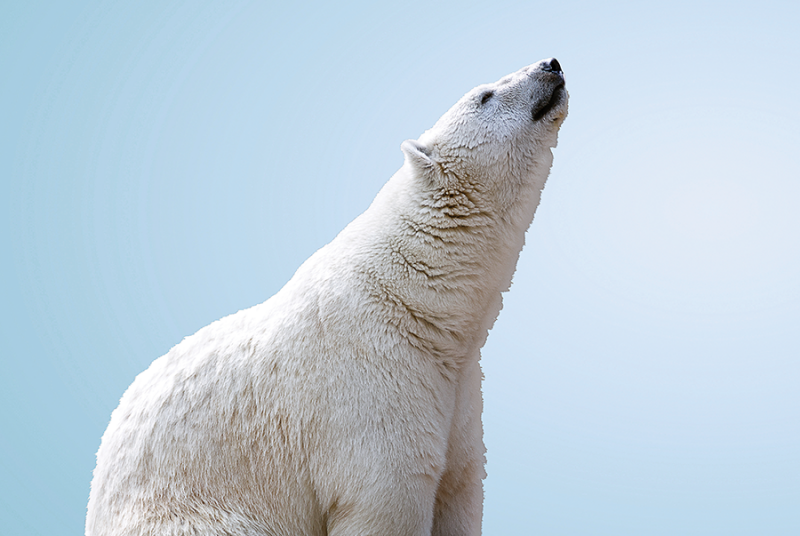Break out the binoculars and commune with nature on a trip to one of these adventuresome spots
Life is short. And as more and more countries reopen their borders to visitors, many people are getting busy planning splurge vacations they’ve been dreaming about for ages.
If going on a safari is on your bucket list, you needn’t limit yourself to Africa. There are dozens of breathtaking spots across the globe where you can commune with wildlife, feel more connected with nature and see animals you probably never knew existed. Pink dolphins? Check. Glass frogs? Absolutely.
Grab your binoculars: Here are five alluring, once-in-a-lifetime safari vacations to take.
Gaze at Polar Bears in Alaska
It’s a sad fact that polar bear populations are dwindling across the globe. But on Alaska’s north coast, visitors can still spot these magnificent predators in their natural habitat, away from crowds.
Kaktovik, Alaska, a remote village along the Beaufort Sea (and the closest Alaskan town to Canada), is the best place within the United States to see polar bears. In the late fall, young male polar bears and females with cubs gather on the islands along the sea to await the sea ice.
From mid-August to early October, Kaktovik turns into a serious safari destination. More than 2,000 people visit every year to take a polar bear safari, and most of the viewing is done in intimate groups of five or fewer. Kaktovik’s safaris are conducted via small boats, which minimizes the human impact on the bears.
Visitors are often surprised by the animals’ sheer size: Polar bears are one of the largest bears in the world, matched only in size by the massive Kodiak brown bears on Kodiak Island in Alaska. They can weigh more than 1,500 pounds and stand up to 10 feet tall. If you look closely through your binoculars, you can see why they’re the only bears that are able to live nearly their entire lives on sea ice, thanks to a thick layer of blubber and waterproof guard hair to keep them warm and dry when they’re swimming.
PRO TIP: For an authentic Alaska experience, book a camping trip through Kaktovik Arctic Tours that includes bear watching, camping and ice fishing with a native Inupiat Eskimo guide. For more information: travelalaska.com
Even though they’re easily recognized because of their snow-white fur, a polar bear’s fur is actually translucent and only appears white because it reflects visible light. And underneath all that fur, the skin is jet black.
Watch Primates Play in Sri Lanka
Although it’s only about the size of West Virginia, Sri Lanka – located off the southeastern tip of India – is one of the most biodiverse places on Earth. In fact, it’s one of only 36 biodiversity hot spots in the world, as designated by Conservation International.
The best way to see wildlife is by taking a trip to Polonnaruwa, which is situated about 40 miles inland from Sri Lanka’s eastern coast. There you’ll find the famed toque macaques, a group of primates that are so animated that they’ve been the subject of numerous nature documentaries, including Animal Planet’s Dark Days in Monkey City and Disney’s Monkey Kingdom. They’re also part of the longest-running study of primates in the world, headed by primatologist Wolfgang Dittus of the Smithsonian Primate Research Station.
What’s so special about these creatures? Many visitors spend hours studying them, as they’re known for their dramatic facial expressions, which signal their mood or attention. For instance, a Sri Lankan monkey who displays a fear grimace – which resembles a smile – is meant as an apology or to stop a fight from happening.
Although the macaques are the stars of the show, they’re not Polonnaruwa’s only primate residents. The city is also home to gray langurs, canopy-dwelling purple-faced leaf monkeys and nocturnal slender lorises.
Also, keep an eye out for the Indian flying fox, one of the largest bats in the world that is native to the Indian subcontinent.
PRO TIP: While in the area, make sure to devote a day to touring the ancient city of Polonnaruwa, where you’ll find structures that have existed for hundreds of years. One example: Polonnaruwa Vatadage, an almost 900-year-old structure, is believed to have held the ancient Relic of the Tooth – the canine tooth of the Buddha left to the king at the time as a show of respect. For more information: srilanka.travel
Toque macaques get their name for the small patch of fur on the top of their head that looks like a tiny hat.
Spot Pink Dolphins in Brazil
Brazil offers some of South America’s most exhilarating wildlife encounters.
One not-to-miss adventure is a visit to Manaus, in the heart of the Amazon, where you can marvel at the pink river dolphins (the locals call them “botos.” The beautiful creatures are considered to be mythical figures; in reality, the pink river dolphin is one of two species of endangered freshwater dolphins that are found in locations throughout the Amazon and Orinoco River basins.
And they’re not just pretty to look at: Pink river dolphins are like gymnasts, thanks to the fact that the vertebrae in their necks are unfused (they’re the only type of dolphin that has this characteristic), so their ability to turn their heads to an angle of 90 degrees allows them to maneuver around tree trunks and all kinds of other obstacles. They can also swim with one flipper while paddling backward with the other, navigating tight turns with more precision.
But scouting out the colorful dolphins won’t be the only highlight of a safari through the Amazon; multi-day treks through the area will include glimpses of jaguars, which are often spotted resting along the banks of the rivers in this area. You’ll also view giant anteaters, endangered glass frogs (named so because of their translucent skin), howler monkeys and marsh deer.
PRO TIP: Most people visit Manaus during the wet season between December and May, when the rain cools the air and makes the temperature a little more bearable, averaging 86 degrees Fahrenheit. For more information: visitbrasil.com
The Amazon pink dolphin has the largest brain of any freshwater dolphin, with 40 percent more brain capacity than that of a human.
Waddle Alongside Penguins in Argentina
While Argentina might best be known for its wine, it’s also one of the best places to see penguins in the wild.
Each fall, along the rocky shores of The National Reserve of Punta Tombo, located on a peninsula in the Atlantic Ocean in Chubut Province, more than a million Magellanic penguins waddle up from the Atlantic Ocean to breed. Outside of Antarctica, the area is the largest penguin colony in the world.
The first penguins arrive in September and stay there through mid-March, but the best season to see them is after November, once the babies are born. During this time, many locals find themselves strolling amidst the penguins on area boardwalks or studying them from wooden bridges as they waddle their way around town.
The best way to view the penguins is by taking a day-long walking tour of the nature reserve offered by one of the many outfitters in the area. (The reserve is located a few hours’ drive from the cities of Trelew and Puerto Madryn.) You’ll see thousands of penguins playing, feeding, swimming and tending to their babies.
PRO TIP: Many of the penguin tours to Punta Tombo are offered with other activities included in the tour. We recommend one that includes a stop for high tea in Gaiman, a Welsh colony that was installed at the end of the 19th century, which is known for its elegant tea houses. For more information: argentina.travel
The black and white “tuxedo” look displayed by most penguin species is actually a clever camouflage called countershading which helps them survive in the wild. When swimming, the black on their backs helps them blend in with the darkness of the ocean from predators viewing from above.
Hop Along with Kangaroos In Australia
Australia is known for kangaroos, of course, but one of the best ways to see the country’s finest creatures is by visiting Kangaroo Island, a 2,773-square-mile landmass covered in dense bushlands, wetlands and forest.
Just 70 miles off the coast of Adelaide (about a 45-minute ferry ride), Kangaroo Island’s isolation has allowed its original wildlife habitat to thrive.
National parks and reserves protect more than a third of the island, and close-up encounters with animals such as Australian sea lions, koalas, echidnas, penguins, and the island’s namesake marsupials, are all possible by booking a variety of tours, ranging from day trips to four-day excursions. Speaking of kangaroos, they’re everywhere, as are koala bears, who you’ll most likely find snoozing in eucalyptus trees. Although you may have traveled to the island for the kangaroos, no visit is complete without a jaunt to Seal Bay, one of the most popular places to see. There, you’ll discover a colony of Australian sea lions as they bask and frolic on the sand and rocks. Don’t forget your camera: Seal Bay is one of the only places on the entire planet where you can get so close to these magnificent creatures.
PRO TIP: Support the island’s small business owners by visiting one of the number of stores selling locally made souvenirs. Merchants include Emu Bay Lavender Farm, Amy Ridge Eucalyptus Oil Distillery and Kangaroo Island Living Honey. For more information: tourkangarooisland.com.au
Powerful hind limbs allow kangaroos to hop huge lengths – up to 25 feet, in a single bound – with incredible efficiency. And they are high jumpers, too: A red kangaroo set a world record clearing a 10-foot stack of timber.


